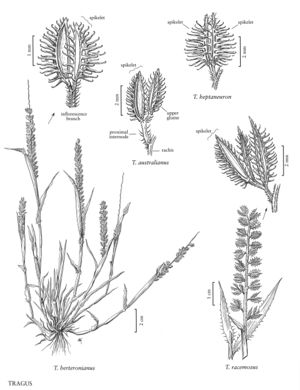Difference between revisions of "Tragus heptaneuron"
FNA>Volume Importer |
FNA>Volume Importer |
||
| Line 17: | Line 17: | ||
-->{{Treatment/Body | -->{{Treatment/Body | ||
|distribution=S.C. | |distribution=S.C. | ||
| − | |discussion=<p>Tragus heptaneuron is native to tropical Africa, but it has been collected in Florence County, South Carolina.</p> | + | |discussion=<p><i>Tragus heptaneuron</i> is native to tropical Africa, but it has been collected in Florence County, South Carolina.</p> |
|tables= | |tables= | ||
|references= | |references= | ||
| Line 38: | Line 38: | ||
|publication year= | |publication year= | ||
|special status= | |special status= | ||
| − | |source xml=https://jpend@bitbucket.org/aafc-mbb/fna-data-curation.git/src/ | + | |source xml=https://jpend@bitbucket.org/aafc-mbb/fna-data-curation.git/src/8f726806613d60c220dc4493de13607dd3150896/coarse_grained_fna_xml/V25/V25_925.xml |
|subfamily=Poaceae subfam. Chloridoideae | |subfamily=Poaceae subfam. Chloridoideae | ||
|tribe=Poaceae tribe Cynodonteae | |tribe=Poaceae tribe Cynodonteae | ||
Revision as of 17:35, 18 September 2019
Plants annual. Culms 15-41cm. Ligules 0.5-1 mm; blades 2.5-7 cm long, 3-5 mm wide, glabrous. Panicles 4-9.5 cm long, 7-9 mm wide; rachises pubescent; branches 0.5-1 mm, pubescent, with 2(3) spikelets, axes not extending past the distal spikelets; proximal internodes 0.5-0.8 mm, longer than the second internodes. Spikelets bisexual; proximal spikelets 3-3.5 mm; second spikelets 2.9-3.3 mm. Lower glumes absent or to 0.4 mm, glabrous; upper glumes 3-3.5 mm, minutely pubescent, 7-veined; glume projections 6-9, in 7 rows, 0.1-0.6(1) mm, uncinate; lemmas (2)2.3-2.7 mm, sparsely pubescent on the back; paleas 2.1-2.3 mm; anthers 3, 0.3-0.6 mm, yellow. Caryopses (1.2)1.4-1.6 mm long, 0.6 mm wide. 2n = unknown.
Distribution
S.C.
Discussion
Tragus heptaneuron is native to tropical Africa, but it has been collected in Florence County, South Carolina.
Selected References
None.
